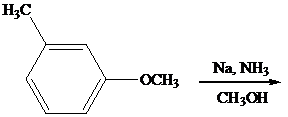
ORGANIC CHEMISTRY (LOOSELEAF)-PACKAGE
10th Edition
ISBN: 9781260008562
Author: Carey
Publisher: MCG
expand_more
expand_more
format_list_bulleted
Concept explainers
Textbook Question
Chapter 12.15, Problem 16P
The regioselectivity of Birch reduction of alkoxy-substituted benzenes is the same as for
alkylbenzenes. What did Arthur Birch isolate when he carried out the following reaction?

Expert Solution & Answer
Want to see the full answer?
Check out a sample textbook solution
Students have asked these similar questions
Assign all the Protons in HNMR
Provide the missing information
HO
NO2
Br2
FeBr3
to
CI
HO
H₂N
NO2
AICI3
Zn(Hg), HCI
1. NBS
2. t-BuONa
1. Br₂, FeBr3
2. CH3CI, AC13
3. Na2Cr2O7
Br
NH2
SO3H
HO
H₂N
Br
Assign the carbon numbered on CNMR
Chapter 12 Solutions
ORGANIC CHEMISTRY (LOOSELEAF)-PACKAGE
Ch. 12.2 - Write structural formulas for toluene (C6H5CH3)...Ch. 12.3 - Prob. 2PCh. 12.5 - Prob. 3PCh. 12.5 - Prob. 4PCh. 12.6 - Prob. 5PCh. 12.6 - Chrysene is an aromatic hydrocarbon found in coal...Ch. 12.8 - Prob. 7PCh. 12.9 - As measured by their first-order rate constants,...Ch. 12.9 - Give the structure of the principal organic...Ch. 12.9 - Prob. 10P
Ch. 12.10 - Prob. 11PCh. 12.11 - Prob. 12PCh. 12.12 - Prob. 13PCh. 12.13 - Prob. 14PCh. 12.13 - Prob. 15PCh. 12.15 - The regioselectivity of Birch reduction of...Ch. 12.16 - Prob. 17PCh. 12.17 - Both cyclooctatetraene and styrene have the...Ch. 12.17 - Prob. 19PCh. 12.18 - Give an explanation for each of the following...Ch. 12.19 - Prob. 21PCh. 12.19 - What does a comparison of the heats of combustion...Ch. 12.20 - Prob. 23PCh. 12.20 - Prob. 24PCh. 12.20 - Prob. 25PCh. 12.20 - Prob. 26PCh. 12.20 - Prob. 27PCh. 12.20 - Prob. 28PCh. 12.21 - Prob. 29PCh. 12.21 - Prob. 30PCh. 12.22 - Prob. 31PCh. 12.22 - Prob. 32PCh. 12 - Write structural formulas and give the IUPAC names...Ch. 12 - Prob. 34PCh. 12 - Prob. 35PCh. 12 - Prob. 36PCh. 12 - Prob. 37PCh. 12 - Acridine is a heterocyclic aromatic compound...Ch. 12 - Prob. 39PCh. 12 - Prob. 40PCh. 12 - Prob. 41PCh. 12 - Evaluate each of the following processes applied...Ch. 12 - Prob. 43PCh. 12 - Prob. 44PCh. 12 - Prob. 45PCh. 12 - Prob. 46PCh. 12 - Anthracene undergoes a DielsAlder reaction with...Ch. 12 - Prob. 48PCh. 12 - Prob. 49PCh. 12 - The relative rates of reaction of ethane, toluene,...Ch. 12 - Both 1,2-dihydronaphthalene and...Ch. 12 - Prob. 52PCh. 12 - Prob. 53PCh. 12 - Prob. 54PCh. 12 - Prob. 55PCh. 12 - Prob. 56PCh. 12 - Each of the following reactions has been described...Ch. 12 - Prob. 58PCh. 12 - A compound was obtained from a natural product and...Ch. 12 - Prob. 60PCh. 12 - Suggest reagents suitable for carrying out each of...Ch. 12 - Prob. 62PCh. 12 - Prob. 63DSPCh. 12 - Prob. 64DSPCh. 12 - Prob. 65DSPCh. 12 - Prob. 66DSP
Knowledge Booster
Learn more about
Need a deep-dive on the concept behind this application? Look no further. Learn more about this topic, chemistry and related others by exploring similar questions and additional content below.Similar questions
- 1 N2H4 (l) + 3 O2(g) > 2 NO2 (g) + 2 H2O (g) If 75.0 kg of hydrazine are reacted with 75.0 kg of oxygen, which is the limiting reactant?arrow_forwardPQ-10. What is the major product of this reaction? (A) (C) 930 Me HO O=S=O O-8-CF, C 어 Me H+ OH 270 O 0-5-0 O=S=O O-S-CF CF3 2arrow_forwardPredict the major organic product(s) of the following reactions. Include stereochemistry when necessary. Write NR if no reaction, try to explain.arrow_forward
- Q2: Explain why epoxides that react in an SN1 manner will not show any stereochemical inversion in the product. Q3: Rationalize why Alcohol B will react under the indicated reaction conditions, but Alcohol A will not. A ☑ OH B OH PBr3 R-Brarrow_forwardQ1: Predict the major organic product(s) of the following reactions. Include stereochemistry when necessary. Write NR if no reaction, try to explain. 1.) LDA, THF 2.) СОН CI OH H2SO4, heat OH m...... OH 1.) PCC, CH2Cl2 2.) CH3CH2MgBr, THF 3.) H3O+ 4.) TsCl, pyr 5.) tBuOK, tBuOH 1.) SOCI 2, CHCI 3 2.) CH3CH2ONA, DMF OH 1.) HBr 2.) Mg, THF 3.) H₂CO, THE 4.) H3O+ OH NaH, THFarrow_forwardWhat is the stepwise mechanism for this reaction?arrow_forward
- Draw the major product of this reactionarrow_forwardPlease provide the IUPAC name for the compound shown herearrow_forwardProblem 6-29 Identify the functional groups in the following molecules, and show the polarity of each: (a) CH3CH2C=N CH, CH, COCH (c) CH3CCH2COCH3 NH2 (e) OCH3 (b) (d) O Problem 6-30 Identify the following reactions as additions, eliminations, substitutions, or rearrangements: (a) CH3CH2Br + NaCN CH3CH2CN ( + NaBr) Acid -OH (+ H2O) catalyst (b) + (c) Heat NO2 Light + 02N-NO2 (+ HNO2) (d)arrow_forward
arrow_back_ios
SEE MORE QUESTIONS
arrow_forward_ios
Recommended textbooks for you

 Organic ChemistryChemistryISBN:9781305580350Author:William H. Brown, Brent L. Iverson, Eric Anslyn, Christopher S. FootePublisher:Cengage Learning
Organic ChemistryChemistryISBN:9781305580350Author:William H. Brown, Brent L. Iverson, Eric Anslyn, Christopher S. FootePublisher:Cengage Learning


Organic Chemistry
Chemistry
ISBN:9781305580350
Author:William H. Brown, Brent L. Iverson, Eric Anslyn, Christopher S. Foote
Publisher:Cengage Learning
Coenzymes and cofactors; Author: CH15 SWAYAM Prabha IIT Madras;https://www.youtube.com/watch?v=bubY2Nm7hVM;License: Standard YouTube License, CC-BY
Aromaticity and Huckel's Rule; Author: Professor Dave Explains;https://www.youtube.com/watch?v=7-BguH4_WBQ;License: Standard Youtube License